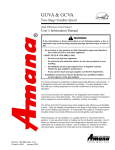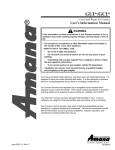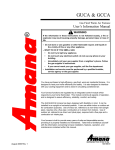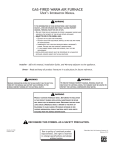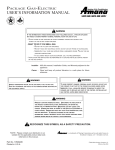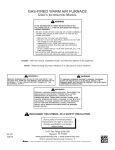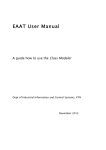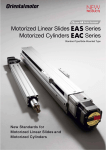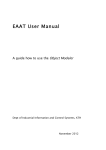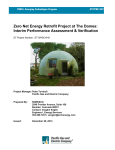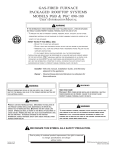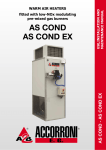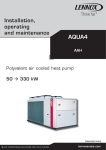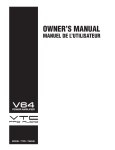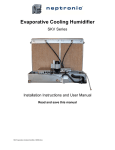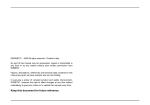Download GULA USER MANUAL
Transcript
GULA Gas Fired Warm Air Furnace ® User’s Information Manual WARNING If the information in these instructions is not followed exactly, a fire or explosion may result causing property damage, personal injury or loss of life. – Do not store or use gasoline or other flammable vapors and liquids in the vicinity of this or any other appliance. – WHAT TO DO IF YOU SMELL GAS: • Do not try to light any appliance. • Do not touch any electrical switch; do not use any phone in your building. • Immediately call your gas supplier from a neighbor’s phone. Follow the gas supplier’s instructions. • If you cannot reach your gas supplier, call the fire department. – Installation and service must be performed by a qualified installer, service agency or the gas supplier. You have purchased a high-efficiency, gas-fired, warm-air residential furnace. It is designed to heat your home efficiently and safely. It is also designed to interface with your cooling equipment and to assist in circulating conditioned air. Your furnace functions are regulated by an integrated control module which responds to your home thermostat. This module controls all aspects of operation, including safety and is designed to assure efficiency, reliability, comfort, and safety. Your furnace is built to provide many years of safe and dependable service, providing it is properly installed and maintained. Take time to familiarize yourself with the information concerning furnace installation, features, operation, and maintenance contained within this manual. Heating & Air Conditioning ® 10318826 October 2002 C om fort. Q uality. Tru st. Contents Important Note To The Owner ............................................................................ 3 Component Identification ...................................................................... 4 General Information ............................................................................... 5 Unit Location ..................................................................................................... 5 Unit Installation ................................................................................................. 5 Clearances and Accessibility ............................................................................ 6 Air Requirements .............................................................................................. 6 Combustion Air (Non-Direct Vent/Single Pipe) ................................................... 6 Flue Pipe and Condensate Drainage ................................................................. 7 Indoor Humidity ................................................................................................. 7 For Propane (LP) Gas Installations Only ........................................................... 8 Operating Your Furnace ........................................................................ 9 Furnace Operation ............................................................................................ 9 Thermostat Functions ....................................................................................... 9 Integrated Control Module .......................................................................... 9 Gas Valve ..................................................................................................... 9 Igniter ........................................................................................................... 9 Blowers ........................................................................................................ 9 Starting Your Furnace ...................................................................................... 10 Shutting Down Your Furnace ........................................................................... 10 Safety Circuits ........................................................................................11 Integrated Control Module ............................................................................... 11 Primary Limit .................................................................................................. 11 Auxiliary Limit ................................................................................................. 11 Rollout Limit .................................................................................................... 11 Pressure Switches .......................................................................................... 11 Flame Sensor ................................................................................................. 11 Resetting From Lockout .................................................................................. 11 Routine Maintenance ........................................................................... 12 Annual Inspection ............................................................................................ 12 Filters ............................................................................................................. 13 Filter Removal ........................................................................................... 13 Filter Cleaning and/or Replacement ........................................................ 13 Troubleshooting / Before You Request a Service Call .................... 14 Safety Labels ......................................................................................... 15 For Additional Information .................................................................... 16 THE INSTALLATION AND SERVICING OF THIS EQUIPMENT MUST BE PERFORMED BY QUALIFIED, EXPERIENCED TECHNICIANS ONLY. Due to policy of continual product improvement, the right is reserved to change specifications and design without notice. RECOGNIZE THIS SYMBOL AS A SAFETY PRECAUTION. 2 WARNING Should overheating occur, or the gas supply fail to shut off, shut off the manual gas valve to the furnace before shutting off the electrical supply. WARNING To avoid death, personal injury or property damage, do not use this furnace if any part of the furnace has been under water. Immediately call a qualified service technician to inspect the furnace and to replace any part of the control system and any gas control having been under water. Important Note To The Owner It is important that you fill out the owner’s registration card and mail it today. This will assist us in contacting you should any service or warranty information change in the future. When filling in the registration card, be sure to include the Model, Manufacturing and Serial Numbers, plus the installation date. If the registration card cannot be located, please call 1-877-254-4729 to register the furnace. Your warranty certificate is also supplied with the unit. Read the warranty carefully and note what is covered. Keep the warranty certificate in a safe place, so you can find it, if necessary. Before using this manual, check the serial plate for proper model identification. Installer - Affix this manual, the Installation Guide, and Specifications Sheet adjacent to the appliance. Owner - Keep all product literature in a safe place for future reference. ATTENTION INSTALLING PERSONNEL As a professional installer you have an obligation to know the product better than the customer. This includes all safety precautions and related items. Remember, it is your responsibility to install the product safely and to know it well enough to be able to instruct a customer in its safe use. Safety is a matter of common sense...a matter of thinking before acting. Most dealers have a list of specific good safety practices...follow them. Prior to actual installation, thoroughly familiarize yourself with this Instruction Manual. Pay special attention to all safety warnings. Often during installation or repair it is possible to place yourself in a position which is more hazardous than when the unit is in operation. The precautions listed in this Installation Manual are intended as supplemental to existing practices. However, if there is a direct conflict between existing practices and the content of this manual, the precautions listed here take precedence. 3 Component Identification 6 8 4 10 3 11 3 * 2 12 * * * * * 1 14 13 15 16 17 * 29 30 28 20 9 * BLOWER COMPARTMENT 7 6 * BURNER COMPARTMENT 5 17 18 19 21 20 21 27 22 23 26 25 24 Upflow /Horizontal (GULA Models) 1 2 3 4 5 6 7 8 9 10 11 12 13 14 15 16 17 18 19 20 21 22 23 Gas Valve Gas Line Entrance (Alternate) Pressure Switch Gas Manifold Hot Surface Igniter Rollout Limit Burners Flame Sensor Flue Pipe Connection / “Coupling” Flue Pipe (Internal) Primary Limit Gas Line Entrance Flue Pipe Connection (Alternate) Rubber Elbow Induced Draft Blower Electrical Connection Inlets (Alternate) 24 25 26 27 28 29 30 4 Coil Front Cover Pressure Tap Coil Front Cover Drain Port Drain Line Penetrations Drain Trap Blower Door Interlock Switch Capacitor Integrated Control Module (with fuse and diagnostic LED) 24-Volt Thermostat Connections Transformer (40 VA) Circulator Blower Auxiliary Limit Junction Box Electrical Connection Inlets Coil Front Cover General Information This furnace is built to provide many years of safe and dependable service, providing it is properly installed and maintained. However, abuse and/or improper use can shorten the life of the furnace and create hazards for you, the homeowner. WARNING This product contains or produces a chemical or chemicals which may cause serious illness or death and which are known to the State of California to cause cancer, birth defects or other reproductive harm. WARNING To avoid possible equipment damage, personal injury, fire or death, the following instructions must be observed regarding unit location, air requirements and operating procedures. WARNING Unit Location 1. The furnace area and the vicinity of any other gas appliances must be kept clear and free of combustible materials, gasoline, and other flammable vapors and liquids. Also, do not store or use flammable items such as paint, varnish, or lacquer in the area. To avoid personal injury or fire, minimum clearances to combustible surfaces must be followed. 7. Make certain the required clearances for the furnace are always maintained. These clearances are listed on the furnace clearance label. If any question develops, contact the installer of the furnace, or another qualified servicer. 2. Do not store or use chlorine or fluorine products (bleaches, cements, strippers, aerosols) near the unit. They can corrode the heat exchanger. 3. Do not use the furnace closet as storage for brooms, mops, brushes and oily rags or cloths. The area must be kept clear, clean and free of lint. Furnace must be kept free and clear of exposed or loose insulation materials in the area of installation. Examine the furnace area when the furnace or additional insulation is added since some insulation materials may be combustible. Unit Installation Examine the furnace installation to determine the following: 1. The flue vent pipe is physically sound, sealed, and well supported. The vent slopes upward to vent terminal so condensate drains back toward the furnace. The vent shows no evidence of leaking or separation at joints or fittings. 4. Make sure the furnace is always connected to an approved vent, in good condition, to carry combustion products outdoors. 2. The return air duct connection is physically sound, sealed to the furnace casing, and terminates outside the space containing the furnace. 5. Familiarize yourself with the controls that shut off the gas and electrical power to the furnace. If the furnace is to be shut down at the end of the heating season, turn off both the gas and electrical power. For safety, always turn the gas and electrical power off before performing service or maintenance on the furnace. 3. The physical support of the furnace is sound without sagging, cracks, or gaps around the base so as to provide a seal between the support and the base. 4. There are no obvious signs of deterioration of the furnace. 6. Establish a regular maintenance schedule to insure efficient and safe operation of the furnace. The furnace should be checked at the beginning of each heating and cooling season by a qualified service technician. 5. Check for proper burner flame performance. Flame should extend directly outward from burners without, curling, floating, or lifting off. 5 General Information Clearances and Accessibility Carbon monoxide or “CO” is a colorless and odorless gas produced when fuel is not burned completely or when the flame does not receive sufficient oxygen. Installations must adhere to the clearances to combustible materials for which this furnace has been design certified. The minimum clearance information for this furnace is provided on the unit’s clearance label. These clearances must be permanently maintained. In addition to the required clearances to combustible materials, a 36-inch minimum for clearance servicing must be available in front of the unit. Unit positioning is referenced as follows: Be aware of these air starvation signals which indicate conditions that may result in carbon monoxide or that carbon monoxide may be present: 1. Headaches-Nausea-Dizziness, Flu-Like Symptoms. 2. Excessive humidity-heavily frosted windows or a moist “clammy” feeling in the home. TOP 3. Smoke from a fireplace will not draw up the chimney. TOP SIDE SIDE 4. Flue gases that will not draw up the appliance vent pipe. SIDE Combustion Air (Non-Direct Vent/Single Pipe) BOTTOM BOTTOM Upflow Counterflow Horizontal WARNING Air Requirements It is vitally important that the furnace have proper venting. To prevent possible death or personal injury due to asphyxiation, this furnace must never be common vented with another gas fired appliance. Any alteration to any venting system must be in accordance with local and national codes, and the manufacturer's instructions. WARNING To avoid death, personal injury or property damage, enough fresh air for proper combustion and ventilation of flue gases must be provided to this furnace. Most homes require outside air to be supplied into the furnace area. In non-direct vent installations (single pipe), the air for combustion and ventilation can typically be obtained from the surrounding unconfined space or louvered closet door. Observe the following precautions concerning air availability: Improved construction and additional insulation in homes have reduced the heat loss and made these homes much tighter around doors and windows so that air infiltration is minimal. This creates a problem to supply ventilation and/or combustion air for gas fired or other fuel burning appliances. Any use of appliances that pull air out of the house (clothes dryers, exhaust fans, fireplaces, water heaters, non-direct vent furnaces, etc.) increases this problem and appliances could be starving for air. • When a furnace is installed in a closet and the closet door is louvered, DO NOT OBSTRUCT LOUVERS. Louvers must be open and clear to provide combustion air to the furnace. • When a furnace is installed in a confined space within a home and the air for combustion and ventilation enters the space through ducts from the outside, be sure to routinely check the entering and outlet, grilled openings to verify that they are always clear and clean. If fuel-burning appliances are starved for air, the flue gases which these appliances produce as they operate may not vent outdoors properly, but remain in the home instead. These flue gases may include carbon monoxide. • Do not partition off a small area around the furnace utilizing a non-louvered door. This could obstruct the combustion air from reaching the furnace. WARNING • Do not allow the furnace’s air intake (top or side) to become blocked. Death or personal injury from asphyxiation can result from exposure to carbon monoxide. • The combustion and ventilation air must never come from a corrosive atmosphere. 6 General Information Flue Pipe and Condensate Drainage Indoor Humidity Relative humidity is the amount of water vapor in the air relative to the amount the air can hold at the same temperature. Example: At 40% relative humidity, the air could hold 2 1/2 times as much moisture (2.5 x 40 = 100%) before becoming saturated. WARNING To prevent possible death or personal injury due to asphyxiation, Amana Condensing Gas Fired Warm Air Furnaces must be Category IV vented. The colder the air; the less moisture it can hold. As air is warmed, its ability to hold moisture is increased. Example: A winter day, outdoor temperature 10°F, and relative humidity of 70%. If that air enters a home and is warmed to 72°F the relative humidity will drop to 6% (very dry) if no more moisture is added. The venting of this furnace (Category IV venting) must be both gas and water tight. For proper performance, the size, length, number of elbows, and termination must be in accordance with the specifications outlined in the furnace installation guide. The flue system must slope towards the furnace for proper condensate drainage. The flue pipe and its termination must be kept clear of blockage. For further information on Category IV venting, refer to the installation instructions accompanying this product. If not included, ask your installing dealer or distributor for this information. Relative humidity is important to your health and home as proper humidification helps reduce respiratory difficulties and helps improve the indoor air quality. A good relative humidity is one just high enough to barely start condensation along the lower edges or lower corners of the windows. More than that can be damaging. Frequent fogging or excessive condensation on inside windows indicates the indoor humidity level is too high for outdoor weather conditions. Damage to the building may result if the condition persists. (Condensation on inside of storm windows indicates loose inside windows. Adding weather-stripping to tighten inside windows usually corrects this problem.) Provisions must be made to drain condensate from the furnace and protect the condensate drain trap and drain lines from freezing conditions. The drain trap and drain lines must be kept clear of blockage. The following table shows the recommended maximum indoor humidity in relationship to the outdoor temperatures. Temperature (° F.) +20° +10° 0° -10° -20° Humidity Table 1 7 35% 30% 25% 20% 15% General Information For Propane (LP) Gas Installations Only For furnaces operating on propane gas, please review the following warnings before use. WARNING To avoid death, personal injury or property damage due to explosion or fire, install a gas detecting warning device. Since the odorant in propane gas can be reduced by iron oxide (rust), a gas detecting warning device is the only reliable method to detect propane gas leaks. WARNING If the gas furnace is installed in a basement, an excavated area or a confined space, it is strongly recommended to contact a propane supplier to install a gas detecting warning device in case of a gas leak. • Since propane gas is heavier than air, any leaking gas can settle in any low areas or confined spaces. • Propane gas odorant may fade, making the gas undetectable except with a warning device. WARNING An undetected gas leak will create a danger of explosion or fire. If the presence of gas is suspected, follow the instructions on the cover of this manual. Failure to do so could result in SERIOUS PERSONAL INJURY OR DEATH. 8 Operating Your Furnace Furnace Operation In the heating mode, gas is burned and the products of combustion are drawn through a heat exchanger by an induced draft blower. The flue gases are then exhausted from your home through a flue pipe system. The furnace’s circulator blower passes indoor air over the heat exchanger and then through the conditioned space. The furnace’s heat exchanger is actually two exchangers, a primary and a secondary, connected in series. The primary heat exchanger is an “aluminized” tubular design built for exceptional durability and efficient heat transfer. The secondary heat exchanger, sometimes referred to as a recuperator coil, is a stainless steel tube and aluminum fin arrangement designed to remove the last remaining heat from the flue gases. The amount of heat withdrawn from the flue gases is so great that the gases are actually cooled to the point of condensing. This furnace therefore produces condensate (water) which must be directed to a drain. Furnaces of this type are referred to as “condensing furnaces”. WARNING Electrical components are contained in both compartments. To avoid electrical shock, injury or death, do not remove any internal compartment covers. Contact a qualified servicer at once if an abnormal condition is noticed. Notice: Do not use this furnace if any part has been under water. Immediately call a qualified servicer to inspect the furnace and to replace any part of the control system and any gas control which has been under water. Keep both doors in place except for inspection and maintenance. An interlock switch prevents furnace operation if the blower door is not in place. Integrated Control Module This furnace is equipped with an integrated control module which regulates all furnace operations. The control responds to input from the thermostat, initiates and controls normal furnace operation, and monitors and responds to all safety circuits. The integrated control module is outfitted with a 3-amp fuse for electrical protection. Thermostat Functions There are many types and styles of thermostats but the operation is usually similar. BE SURE TO BECOME FAMILIAR WITH YOUR THERMOSTAT. The simplest type of thermostat only starts and stops the furnace to maintain the desired room temperature. The most widely used types will control both heating and cooling functions and will have a Fan Switch with Auto and ON settings. On Auto, the circulating air blower will cycle on/off with the furnace but if switched to ON it will run continuously regardless of whether or not heating or cooling is being provided. Gas Valve The gas valve regulates gas flow to the burners in response to input from the integrated control module. Igniter The furnace has an electronic ignition device which lights the burners automatically, never try to light the burners by hand. In addition, there are thermostats which automatically switch from heating to cooling mode and those with night set back capability. The night set back, or multiple set back, type allows for a different temperature at night or during the day when no one is at home. Programmable thermostats will allow for more control and tailoring of the heating and cooling functions. The level of this control will depend on the type of thermostat applied. Room Temperature Thermostat Cool/Heat Temperature Control Dials Fan Switch System Switch OFF Fan Switch AUTO COOL AUTO COOL ON HEAT AUTO HEAT ON OFF ON Blowers An induced draft blower is utilized to draw flue products through the heat exchanger and exhaust them outdoors. The circulator or main blower passes indoor air over the heat exchanger and throughout the conditioned space. Both blowers are permanently lubricated, no further oiling is required. Action None System only cools, fan cycles off and on. System only cools, fan runs all the time. System only heats, fan cycles off and on. System only heats, fan runs all the time. No heating or cooling, fan runs all the time. Cool/Heat Switch Typical Thermostat 9 Operating Your Furnace Starting Your Furnace Gas Valve On/Off Selector Switch To put your furnace into operation, follow the steps listed below. Inlet Pressure Tap 1. Close the external manual gas shut-off valve. 2. Turn off the electrical power to the furnace. 3. Set the room thermostat to the lowest possible setting. INLET OUTLET 4. Remove the burner compartment door. 5. This furnace is equipped with an ignition device which automatically lights the burner. Do not try to light the burner by hand. Pressure Regulator Adjustment (Under Cap Screw) 6. Move the furnace’s gas valve ON/OFF switch to the OFF position. Outlet Pressure Tap White-Rodgers Model 36G22 7. Wait five minutes to clear out any gas. Then smell for gas, including near the floor as some types of gas are heavier than air. Shutting Down Your Furnace To shut down your furnace, follow the steps listed below. 8. If you smell gas following the five minute waiting period in step 7, immediately follow the instructions on the cover of this manual. If you do not smell gas after five minutes, move the furnace’s gas valve ON/OFF switch to the ON position. 1. Set the thermostat to the lowest setting. 2. Integrated control closes gas valve extinguishing flame. 10. Open the external manual gas shut-off valve. 3. Induced draft blower is de-energized following a 15 second delay. The circulator blower is de-energized following a 60, 90, 120, or 180 second delay period. 11. Turn on the electrical power to the furnace. 4. Remove the burner compartment door. 12. Adjust the thermostat to a setting above room temperature. 5. Move the furnace’s gas valve ON/OFF switch to the OFF position. 13. After the burners are lit, set the thermostat to desired temperature. 6. Close the external manual gas shut-off valve. 9. Replace the burner compartment door. 7. Replace the burner compartment door. 10 Safety Circuits A number of safety circuits are employed to ensure safe and proper furnace operation. These circuits serve to control any potential safety hazards and, as inputs in the monitoring and diagnosis of abnormal function. These circuits are continuously monitored by the integrated control module. Integrated Control Module ROLLOUT LIMIT(S) The integrated control module is an electronic device which regulates all furnace operations. Responding to the thermostat, the module initiates and controls normal furnace operation, and monitors and addresses all safety circuits. If a potential safety concern is detected, the module will take the necessary precautions and provide diagnostic information through an LED displayed on the module. PRIMARY LIMIT FLAME SENSOR PRESSURE SWITCH PRESSURE SWITCH Primary Limit BLOWER DECK The primary limit control is located on the partition panel and monitors heat exchanger compartment temperatures. It is a normally closed (electrically), automatic reset, temperature activated sensor. This limit guards against overheating as a result of insufficient conditioned air passing over the heat exchanger. CIRCULATOR BLOWER Auxiliary Limit AUXILIARY LIMIT (UNDERSIDE OF BLOWER DECK) Safety Circuits The auxiliary limit control is located on or near the blower deck and monitors heat exchanger compartment temperatures. It is a normally closed (electrically), manual reset, temperature activated sensor. This limit guards against overheating as a result of insufficient conditioned air passing over the heat exchanger. Resetting From Lockout Furnace lockout is characterized by a non-functioning furnace (circulator blower may be running continuously) providing a one flash diagnostic LED code. Lockout results when a furnace is unable to achieve ignition after three attempts, or when it has lost flame five times during a single call for heat. If the furnace is in “lockout”, it may be reset by any of the following methods: Rollout Limit The rollout limit is a normally-closed (electrically), manual-reset, temperature-activated sensor. It is mounted on the burner/manifold assembly and monitors the burner flame. If there is an improper draw of burner flames into the heat exchanger, the rollout limit will detect it and shutdown gas flowing to the burners. 1. One hour automatic reset. Control will automatically reset itself and attempt to resume normal operations following a one hour lockout period. 2. Power interruption. Interrupt 115 volt power to the furnace for between 0 and 20 seconds. Pressure Switches 3. Thermostat cycle. Interrupt thermostat signal to the furnace for between 0 and 20 seconds. The pressure switches are normally-open (closed during operation), single-pole single-throw, negative air pressure activated switches. They monitor the airflow (combustion air and flue products) through the heat exchanger via pressure taps located on the induced draft blower and the coil front cover. These switches guard against insufficient airflow (combustion air and flue products) through the heat exchanger and blocked condensate drain conditions. If the condition which originally caused the lockout still exists, the control will return to lockout. If your furnace frequently locks out, a problem exists which must be corrected. Contact a qualified servicer. Flame Sensor The flame sensor is a probe mounted to the burner/manifold assembly which uses the principle of flame rectification to determine the presence or absence of flame. 11 Routine Maintenance If you perform maintenance on the furnace yourself, remember that certain mechanical and electrical knowledge, skills and tools are required to perform maintenance on the furnace. Personal injury or death my result. If you are not properly trained. You should call your installing dealer or place of purchase if you are uncertain about your ability to perform maintenance. WARNING To avoid death or personal injury due to electrical shock, disconnect the electrical power before performing any maintenance. Annual Inspection The furnace should be inspected by a qualified installer, or service agency at least once per year. This check should be performed at the beginning of the heating season. This will insure that all furnace components are in proper working order and that the heating system functions appropriately. Particular attention should be paid to the following items. Repair as necessary. • Flue pipe system. Check for blockage and/or leakage. Check the outside termination and the connections at and internal to the furnace. • Heat exchanger. Check for corrosion and/or buildup within the heat exchanger passageways. • Burners. Check for proper ignition, burner flame, and flame sense. Flames should extend directly outward from burners without curling, floating or lifting off. • Drainage system. Check for blockage and/or leakage. Check hose connections at furnace. • Wiring. Check electrical connections for tightness and/or corrosion. Check wires for damage. • Filters. Check that filters are clean and in the proper placement in the furnace or duct system. 12 Check the burner flames for: 1. Good adjustment 2. Stable, soft and blue 3. Not curling, floating, or lifting off. Burner Flame Routine Maintenance Filters Filters must be inspected, cleaned or changed every two months or as required. As a homeowner, it is your personal responsibility to keep air filters clean. Remember that dirty filters are the most common cause of inadequate heating or cooling performance. Return air filters are supplied by your installer. Become familiar with where the filter is located and the procedure(s) for removing, cleaning and replacing them. If assistance is needed, contact either the installer of your furnace or a qualified servicer. WARNING To avoid death, personal injury or property damage, disconnect electrical power before removing filters never operate furnace without a filter installed. Dust and lint will build up on internal parts resulting in loss of efficiency, equipment damage and possible fire. Filter Removal Filter Cleaning and/or Replacement Filters are located either at the unit or in a central return grille. Horizontal installations will use a ductwork or central return grille location. Disposable filters must be replaced with a filter or filters of the same size as that which is removed. Filters must comply with UL900 or CAN/ULC-S111 Standards. To remove filter(s) from the ductwork or central return grille installation: Permanent filters must be cleaned, washed, and dried as specified by the filter manufacturer. Filters which use a dust adhesive should be sprayed or oiled as recommended by the filter and adhesive manufacturers. If it becomes necessary to replace a permanent filter, it must be replaced with a filter or filters of the same size as that which is removed. Filters must comply with UL900 or CAN/ULC-S111 Standards. 1. Turn off electrical power to the furnace. 2. Remove filter(s) from ductwork or central grille location. 3. Replace filter(s) opposite removal. If using Media Air Cleaner MAC1 or Electronic Air Cleaner EAC6, follow the directions provided with the air cleaner for proper filter removal, cleaning, and replacement. When reinstalling filters, be careful to maintain correct airflow direction. 13 Troubleshooting / Before You Request a Service Call If your furnace is not operating or is performing improperly, take time to perform the following checks before requesting service. A couple of simple checks may allow you to avoid a service call. If the following steps do not resolve the problem, contact a qualified servicer for further troubleshooting and/or repairs. Do not attempt troubleshooting beyond that which is outlined below. Do not attempt repairs yourself. Use the diagram on page 4 for parts reference. If your furnace will not start, check the following (in sequence): NOTE: If flashing, the integrated control module diagnostic LED flash code must be recorded prior to turning off the power to the furnace or opening the blower compartment door. To determine the flash code, count the number of flashes seen through the blower compartment door sight glass. • • • • Check thermostat for proper operation. Verify that it is set on HEAT and that temperature (above room temperature) setting is appropriate. Check to see that the electrical disconnect at the furnace location is in the ON position. If the switch is in the OFF position, switch it to the ON position to supply electrical power to the furnace. Check fuse or circuit breaker in furnace electrical circuit. Replace as necessary. Check to see that the manual gas shut-off valve external to the furnace is in the ON position. If the valve is in the OFF position, turn the gas ON following the start up procedures outlined in the “Starting Your Furnace” section. NOTE: If flashing, record the integrated control module diagnostic LED flash code prior to power interruption. Turn off furnace electrical power prior to proceeding. • • • • Remove burner compartment door and check to see that gas valve ON/OFF switch is in the ON position. (See figure on page 10) If the switch is in the OFF position, turn the gas ON following the start up procedures outlined in the “Starting Your Furnace” section. Remove blower compartment door and check to verify whether or not the manual reset auxiliary limit control has tripped. The auxiliary limit control is located on or near the circulator blower. (See figure on page 4) If the auxiliary limit control has tripped, a reset “click” will be heard when the red button on the back of the control is pressed. Replace door. NOTE: Do not reset the auxiliary limit control more than once. If the control trips again, follow the furnace shut down procedure outlined in the “Starting Your Furnace” section and contact a qualified servicer. Check for blockage at the termination(s) of flue pipe (and the combustion air intake pipe where present). Also for blockage in the drain trap. Clear if possible. (See figure on page 4) Check for blockage in the drain lines. If blockage is present, please contact a qualified servicer. 14 WARNING: IMPROPER INSTALLATION, ADJUSTMENT, ALTER- ATION, SERVICE OR MAINTAINANCE CAN CAUSE PROPERTY DAMAGE, PERSONAL INJURY OR LOSS OF LIFE, EXPOSURE TO SUSTANCES IN FUEL OR FROM FUEL COMBUSTION WHICH CAN CAUSE DEATH OR SERIOUS ILLNESS, AND WHICH ARE KNOWN TO THE STATE OF CALIFORNIA TO CAUSE CANCER BIRTH DEFECTS, OR OTHER REPRODUCTIVE HARM. REFER TO THE USER'S INFORMATION MANUAL PROVIDED WITH THIS FURNACE. INSTALLATION AND SERVICE MUST BE PERFORMED BY A QUALIFIED INSTALLER, SERVICE AGENCY OR THE GAS SUPPLIER. DO NOT STORE OR USE GASOLINE OR OTHER FLAMMABLE VAPORS AND LIQUIDS IN THE VICINITY OF THIS OR ANY OTHER APPLIANCE. FOR YOUR SAFETY SEE INSIDE SURFACE OF LOUVERED DOOR FOR LIGHTING/OPERATING INSTRUCTIONS. 15 WARNING R is k o f e l e c t r ic s h o c k o r d e a t h . D is c o n n e c t r e m o t e e l e c t r ic p o w e r s u p p ly o r s u p p lie s b e f o r e s e r v ic i n g . T h i s c o m p a r t m e n t m u s t b e c lo s e d e x c e p t w h e n s e r v ic in g . AVERTISSEMENT D ange r de choc électriq ue ou d e m o rt. D é bra ncher to ute bo ite á fu sibles a va nt l'en tretien . C e com p artm e nt d oit re ster fe rm e, sa u f p ou r l'en tretien . MANUAL GAS LEVER SHOWN IN ON POSITION ROBINET A GAZ MANUEL, EN POS "ON/MARCHE" 1. Set the thermostat to lowest setting. 2. Turn off all electric power to the appliance if service is to be performed. 3. Push the gas control lever to "OFF" Position. Do not force. 4. Replace control access panel. TO TURN OFF GAS TO APPLIANCE 1. STOP! Read the safety information above on this label. 2. Set the thermostat to lowest setting. 3. Turn off all power to the appliance. 4. This appliance is equipped with an ignition. device which automatically lights the burner. Do not try to light the burner by hand. 5. Push the gas control lever to "OFF" Position. Do not force. 6. Wait five (5) minutes to clear out any gas. Then smell for gas, including near the floor. If you then smell gas, STOP! Follow "B" in the safety. information above on this label if you don't smell gas, go to next step. GAS 7. Push gas control lever INLET to "ON". 8. Replace access panel. 9. Turn on all electric ARRIVEE power to the appliance. DU GAZ 10.Set thermostat to desired setting. 11.If the appliance will not operate, follow the instructions "To Turn Off Gas To Appliance" and call your service technician or gas company. OPERATING INSTRUCTIONS D. Do not use this appliance if any part has been underwater. Immediately call a qualified service technician to inspect the appliance and to replace any part of the control system and any gas control which has been underwater. C. Use only your hand to push in or turn the gas control lever. Never use tools. If the lever will not push in or turn by hand, don't try to repair it, call a qualified service technician. Force or attempted repair may result in a fire or explosion. Do not try to light any appliance. Do not touch any electric switch; do not use any phone in your building. Immediately call your gas supplier from a neighbor's phone. Follow the gas supplier's instructions. If you cannot reach your gas supplier, call the fire department. WHAT TO DO IF YOU SMELL GAS B. BEFORE OPERATING smell all around the appliance area for gas. Be sure to smell next to the floor because some gas is heavier than air and will settle on the floor. A. This appliance does not have a pilot. It is equipped with an ignition device which automatically lights the burner. Do not try to light the burner by hand. explosion may result causing property damage, personal injury or loss of life. FOR YOUR SAFETY READ BEFORE OPERATING WARNING: If you do not follow these instructions LES INDICATIONS POUR L'ECLAIRAGE ET LE SERVICE SE TROUVENT A LA SURFACE INTERIEURE DE LA PORT A JALOUSIES. 11072712 1. Régler le thermostat à la température la plus basse. 2. Couper l'alimentation électrique de l'appareil s'il faut procéder à des opérations d'entretien. 3. Pousse le levier du contrôle du gaz à "OFF / ARRET" position. Ne pas forcer. 4. Remettre en place le panneau d'accès. POUR COUPER L'ADMISSION DE GAZ DE L'APPAREIL 1. ARRETÊR! Lisez les instructions de sécurité sur la portion supérieure de cette étiquette. . 2. Régler le thermostat à la température la plus basse 3. Couper l'alimentation électrique de l'appareil. 4. Cet appareil ménager étant doté d'un système d'allumage automatique, ne pas essayer à allumer le brûleur manuellement. 5. Pousse le levier du contrôle du gaz à "OFF/ ARRET" position. 6. Attendre cinq (5) minutes pour laisser echapper tout le gaz. Renifler tout autour de l'appareil, y compris près du plancher, pour déceler une odeur de gaz. Si c'est le cas, ARRETER! Passer à l'étape B des instructions de sécuritié sur la portion supérieure de cette étiquette. S'il n'y a pas d'odeur de gaz, passer à l'étape suivanté. 7. Pousse le levier du contrôle du gaz à "ON/MARCHE" position. 8. Remettre en place le panneau d'accés. 9. Mettre l'appareil sous tension. 10. Régler le thermostat à la température desirée. 11. Si l'appareil ne se met pas en marche, suiyre les instructions intitulées. Comment coupler l'admission de gaz de l'appereil et appeler un technicien qualifié ou le fourrnisseur de gaz. MISE EN MARCHE dans l'eau, complètement ou en partie. Appeler un technicien qualifié pour inspecter l'appareil et remplacer tout partie du système de contrôle et toute commande qui ont été plongés dans l'eau. D. Ne pas se servir de cet appareil s'il a été plongé Ne pas tenter d'allumer l'appariel Ne toucher aucun interrupteur électrique; n'utiliser aucun téléphone dans le bâtiment. Appeler immédiatement le fournisseur de gaz en employant le téléphone dún voisin. Respecter à la lettre les instructions du fournisseur de gaz. Si personne ne répond, appeler le service des incendies. C. Ne pousser ou tourner le levier d'admission du gaz qu'à la main; ne jamais emploer d'outil à cet effet. Si la manette reste coincée, ne pas tenter de la réparer; appeler un technicien qualifié. Quiconque tente de forcer la manette ou de la reparer peut déclencher une explosion ou un incendie. QUE FAIRE S'IL Y A UNE ODEUR DE GAZ renifler tout autour de l'appariel pour déceler une odeur de gaz. Renifler près du plancher, car certains gaz sont plus lourds que l'air et peuvent s'accumuler au niveau du so.l B. AVANT DE LE FAIRE FONCTIONNER, muni d'un dispositif d'allumage qui allume automatiquement le brûleur. Ne pas tenter d'allumer le brûleur manuellement. A. Cet appareil ne comporte pas de veilleuse. Il est la lettre les instructions dans le présent manuel risque de déclecher un incendie ou une explosion entraînant des dammages matériels, des lésions corporelles ou la perte de vies humaines. LIRE AVANT DE METTRE EN MARCHELIRE AVERTISSEMENT: Quiconque ne respecte pas á Safety Labels NOTE: If safety labels are missing or illegible, contact the installing dealer or our Customer Service Department for ordering information. AVERTISSEMENT: UNE INSTALLATION, UN REGLAGE, UNE MODIFICATION, UNE ENTRETIEN, OU UNE MAINTAINANCE INCORRECTS PEUVENT ENTRAINER DES DOMMAGES MATERIALS, DES LESIONS CORPORELLES OU LA PERTE DE VIES HUMAINES. CONSULTER LE MANUEL DES USAGER FOURNI AVEC CE GENERATEUR D'AIR CHAUD. L'INSTALLATION ET L'ENTRETIEN DOIVENT ETRE EFFECTUE'S PAR UN INSTALLATEUR QUALIFIE, UN ORGANISME DE MAINTENANCE OU LE FOURNISSEUR DE GAZ. NE PAS ENTREPOSER NI UTILISER DE L'ESSENCE NI D'AUTRES VAPEURS OU LIQUIDES INFLAMMABLES DANS LES VOISINAGES DE CET APPAREIL, NI DE TOUT AUTRE APPAREIL. AVERTISSEMENT 10232005 For Additional Information Most questions can be answered by your local Amana dealer. If you need further information regarding the operation, maintenance, or service of your furnace, contact your dealer. If you have other matters that cannot be resolved locally, or you need additional information regarding other heating and cooling products offered by us - please call: CONSUMER INFORMATION LINE AMANA TOLL FREE 1-877-254-4729 (U.S. only) email us at: [email protected] fax us at: (931) 438- 4362 (Not a technical assistance line for dealers.) Outside the U.S., call 1-931-433-6101. (Not a technical assistance line for dealers.) Your telephone company will bill you for the call. Ask a participating Amana dealer about our extended service plan. It adds to the strong warranty with additional parts and labor coverage. ® TM EXTENDED SERVICE PLAN To obtain the proper labels, the Model, Manufacturing Number and Serial Number of the unit must be supplied. These numbers are recorded on the nameplate of the furnace. For convenience, record this information here: MODEL NUMBER: _ _ _ _ _ _ _ _ _ _ _ MANUFACTURING NUMBER: P _ _ _ _ _ _ _F SERIAL NUMBER: _ _ _ _ _ _ _ _ _ _ 16 17 ® is a trademark of Maytag Worldwide N.V. and is used under license to Goodman Company, L.P. All rights reserved. 18



















